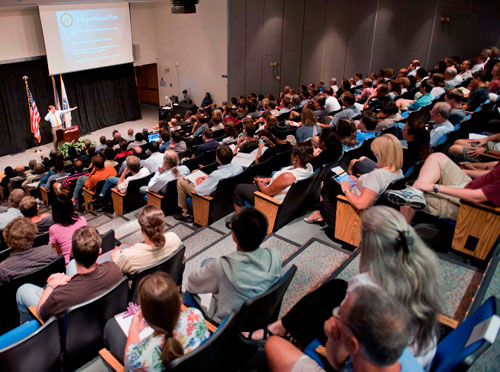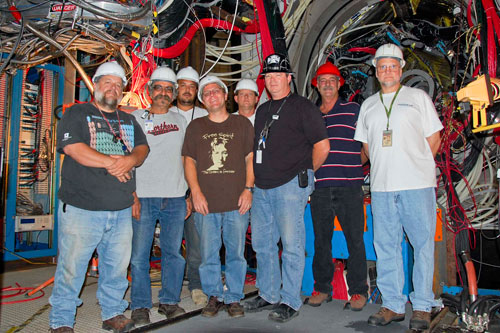
|
September 2011
|
|
|
The U.S. Department of Energy's Thomas Jefferson National Accelerator Facility
|
|
Projects and Special and Natural Events |
|
August at Jefferson Lab was abuzz with programmed activities, special events, and responding to a range of natural phenomena. Good progress was made on major projects like the 12 GeV Upgrade and the Technology and Engineering Development Facility, as well as work in the halls in preparation for the experiment run scheduled to begin in November. The lab also hosted a visit by Sen. Mark Warner on Aug. 18 and conducted the semi-annual Program Advisory Committee meeting Aug. 22-26. Work deviated from planned activities only long enough to deal with the after effects of a 5.8 earthquake that rocked the region on Aug. 23 and Hurricane Irene, which hit Hampton Roads Aug. 27-28. The Six-Month Shutdown passed the halfway point in mid-August. Major milestones were achieved by the Magnet Factory team in the refurbishment of the East and West Arc dipole magnets, and installation of new magnets...... more |
|
|
Accelerator R&D Enables Better Nuclear Physics Research
|
Lab Earns International Safety Certification
|
Cryo Engineer Wins Award Named for Mentor Who Inspired Him
|
||
|
|
||||
Below the Fold:
|
||||
Accelerator R&D Enables Better Nuclear Physics Research |
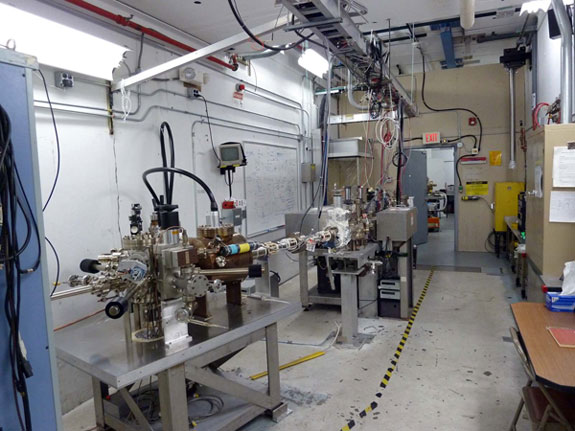 Members of JLab's Center for Injectors and Sources carried out their research measurements over a period of six years in the Test Lab's Injector Test Cave.
In the weeks before the six-month shutdown, Jefferson Lab's CEBAF accelerator churned out record numbers of electrons for experiments. The feat was a culmination of a six-year effort by Jefferson Lab's Center for Injectors and Sources. CIS members carried out studies to quantify the best conditions for coaxing the most electrons out of an accelerator's electron source. The studies centered on the photocathode, a dime-sized, flat wafer of shiny, dark-gray material made of gallium arsenide. When laser light of the appropriate wavelength illuminates its surface, the photocathode releases electrons. These freed electrons feed the CEBAF accelerator and are ultimately used to probe the nucleus and its protons and neutrons. A "fresh" photocathode produces far more electrons per second than any experiment at CEBAF can use. However, that capability decreases in proportion to the total number of electrons it provides. Heavily demanding experiments, such as Q-weak, can use nearly a million-billion electrons per second, requiring a new photocathode after about a week. "The ideal photocathode would not degrade; it would have an unyielding high efficiency to provide electrons. One of our jobs is to figure out what we can do to achieve this goal," said Joe Grames, an injector scientist in Jefferson Lab's Accelerator Division CIS group. Over six years, CIS members Riad Suleiman, Grames and their colleagues tested under extreme conditions handfuls of GaAs photocathodes in tightly controlled experiments in hopes of identifying the factors that burn them out. Their studies focused on performance issues identified largely through experience running CEBAF and from other electron accelerators. The CEBAF accelerator's electron source is aimed squarely at providing electrons for nuclear physics research. Therefore, a key factor in the success of these experiments was the opportunity to conduct these tightly controlled measurements at the Test Lab's Injector Test Cave. Grames said the Test Cave setup is nearly identical to the first few meters of CEBAF. Like the CEBAF accelerator electron source, the Test Cave beam line provides the key ingredients – a sophisticated electron gun to manage and prepare the photocathodes, extreme high-vacuum beam line components and chambers, along with high-power lasers to produce and high-voltage power supplies to accelerate and form the electron beam. In May, CEBAF's electron source churned out 18.9 Coulombs' worth of electrons in a 24-hour period during the last week of continuous running before the Six Month Shutdown began.
"Everything we learned there, we could apply to the injector in CEBAF," Suleiman said. Four Conditions One condition involves the so-called active area on the photocathode. This area on the photocathode is chemically prepared to release electrons when struck with laser light. While a larger active area provides more surface from which electrons can be produced, a larger active area could also lead to more ion damage. Researchers measured the importance of limiting this area to prevent the release of rogue electrons that inadvertently lead to ion damage. Another concern is the choice of location on the photocathode where the laser beam strikes, the so-called laser spot. The CEBAF laser spot is smaller than the active area, so the spot can be positioned in a handful of locations within one active area. Simply put, the researchers mapped in great detail how damage to the laser spot accumulated in relation to its distance from the center of the electron gun. Another method to reduce wear at the laser spot is to enlarge the laser beam size. De-focusing the laser and allowing it to shine on a larger portion of the active area provides a larger area from which electrons can emerge from the photocathode. This larger area effectively spreads the ion damage over the surface, meaning it takes longer (or rather takes more ions) to accumulate and render the photocathode unusable at the laser spot. The team measured significant improvement with modest increase in laser spot size. The last factor the researchers found they could alter is the use of a different style of anode, the last element in the electron gun. Ions are created in the electron gun itself, but also downstream in the beam pipe that connects the gun to the accelerator. By applying a small positive voltage (bias) to the anode, researchers were able to repel them from entering the electron gun, limiting their contribution to photocathode decay. Accumulated Benefit "This work has allowed us to understand in greater detail the impact of each of these conditions as they collectively affect photocathode lifetime. Here are now four tools in the toolbox," Grames said. What’s next? "The higher voltage supports our higher current customers. We are running Q-weak at 130 kilovolts, more effectively transporting the electron beam than we could have at our previous 100 kilovolts," Grames said. "We want to build higher voltage electron guns to benefit CEBAF and other accelerators and explore how this may extend photocathode lifetime." Grames and Suleiman see potential for improving photocathode performance using all of the [above] parameters in future electron guns. For instance, photocathode performance in Jefferson Lab's Free-Electron Laser and similar electron guns are subject to the same physics and could benefit from this research. "If you need longer lifetime, now we know how to make it longer; if you need to sustain high current longer, now we know how. Now, you can calculate your numbers and find the best way to optimize your system," Suleiman said. The results were published in the April issue of Physical Review Special Topics - Accelerators and Beams in a paper titled "Charge and fluence lifetime measurements of a dc high voltage GaAs photogun at high average current." By Kandice Carter Reference: |
Cryo Engineer Wins Award Named for Mentor Who Inspired Him |
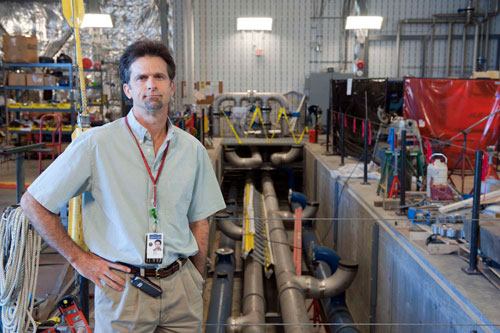 Cryogenics Group Senior Engineer Kelly Dixon stands inside the Central Helium Liquefier compressor room addition. The addition was needed to meet the cryogenic cooling requirements for the 12 GeV Upgrade. The trench Dixon is standing in front of contains piping for water cooling and helium suction manifolds. The piping on the wall carries helium.
In some ways, life has come full circle for Senior Engineer Kelly Dixon. The Jefferson Lab Cryogenics group member was awarded the George T. Mulholland Memorial Award for Excellence in Cryogenic Engineering by the Cryogenic Society of America during its annual meeting in June. Dixon credits Mulholland for giving his life and career path a much needed focus when he was an undergraduate. Dixon, gifted in math, had chosen engineering as his major at the University of Illinois at Champaign-Urbana because it seemed like a practical path to a career. But he wasn't finding it terribly engaging. Then, a meeting with Mulholland during a summer job at Fermilab changed everything for him. "I met George Mulholland there on my last day, and he introduced me to cryogenics by showing me the large scale refrigeration equipment and demonstrating how a gas expansion engine works," Dixon recalled of the man who would become a noted leader of the CSA. "He was so passionate about the work that it helped erase the doubts I had about entering this field. I was hooked!" After graduation in 1980, Dixon returned to Fermilab for a 12-year period, during which he eventually worked with Mulholland and held a variety of positions with increasing responsibilities. As an engineer on his first project, he managed a group of technicians and worked with senior engineers through the design, fabrication, and commissioning stages of a 1kW hydrogen refrigerator and then led a team through installation and start up of cryogenic systems supporting a 66,000-liter argon calorimeter and later for Fermilab's D0 calorimeter. As an operations manager, he supervised a crew of six to operate a 30,000-liter liquid hydrogen bubble chamber safely and efficiently while providing important physics results to numerous experiments. By the early 1990s, he moved on to the Product Development Group at BWX Technologies (formerly known as Babcock & Wilcox) in Lynchburg, Va. There, he led a team of engineers and technicians from initializing the detailed process design through the commissioning phase of a cryogenic test facility where vertically oriented quadrupole collared coils and cold mass assemblies were evaluated in liquid helium. During this time he also worked on various magnet current leads for different fluids, temperatures, currents, and voltages. This work led to a patent, along with two other engineers, for a Modular High Temperature Superconducting Down Lead with Safety Lead. Dixon came to Jefferson Lab in May 2000. He initially led design efforts of the linear accelerator (linac) warm and cryogenic piping, guard vacuum and nitrogen distribution systems for the Spallation Neutron Source project being built for the Department of Energy in Oak Ridge, Tenn. He then started supporting and leading many 12 GeV Upgrade cryogenics design efforts for systems including compressors, the 2K cold box, linac valve modifications and warm piping development. As an operations engineer, he provided operational support to all the cryogenic activities in the Test Lab, including overseeing system upgrades, testing, troubleshooting and maintenance efforts on compressors, vacuum equipment and transfer line piping. Now, as project engineer for 12 GeV Upgrade cryogenic activities, he's busy directing the efforts of the mechanical and design teams, and monitoring and leading major equipment procurements such as the warm compressor skids, cold box, oil removal and dewars. He's also overseeing and helping to develop building and equipment layouts for the 12 GeV Central Helium Liquefier compressor room and the Hall D Cryo Building, as well as for the End Station Refrigerator 4kW Refrigerator Building. "My time is consumed by work on the upgrade right now," he noted. "I have to make sure everything is built to specifications, and make sure everything is getting here and installed in a timely fashion. It's going to be a very exciting next couple of years." Over the years, he has co-authored more than a dozen technical papers. And, in 2007 he was one of six Jefferson Lab Cryo team members recognized by the federal government with a White House Closing the Circle Award. The team developed a series of innovative energy-saving processes that resulted in cutting the power requirements of industrial-sized refrigeration systems, increased the time between necessary maintenance periods for the compressors and automated certain refrigeration-system processes. The team's efforts have resulted in cost savings and system improvements for Jefferson Lab and other DOE laboratories, NASA and commercial refrigeration plants. Dixon and his wife, Stephanie, live in Newport News. They share a passion for tennis and golf. In fact, they met on a golf course, and are both members of the lab's golf league. She was formerly an engineer at the Newport News Shipyard and then pursued an MBA that led to work as a product manager for a local seafood company. Now, she is trying to stay viable as a realtor. What is the Cryogenic Society of America?
The Cryogenic Society of America is an international technical society serving those interested in any phase of cryogenics – the art and science of achieving extremely low temperatures – almost absolute zero. It was formed in 1964 and derived most of its initial members from the aerospace industry. However, membership now includes engineers, physicists, other scientists, sales representatives, technicians, all levels of management, systems designers and operators and a host of other occupations – with a wide range of academic degrees. In 1971, the Helium Society was incorporated into CSA.. Dixon is an outdoor enthusiast, and enjoys riding with the lab's lunchtime bicycle group. He also is an avid hiker and backpacker and is captain of a team in an eight-ball pool league. Receiving the Mulholland Award came as complete surprise, he said. "I can think of several engineers here at the lab that are more deserving. I'm guessing that achieving this award has more to do with being associated with our cryogenics group that is increasingly recognized for the excellent work it produces here and elsewhere rather than any personal accomplishment. Receiving this award was very gratifying. It's especially meaningful to me since it's named for George Mulholland. He had a real ability to tackle hard problems and to stand his ground. I admired that." By Judi Tull |
JLab Visiting Researcher Earns Prestigious 3M Teaching Fellowship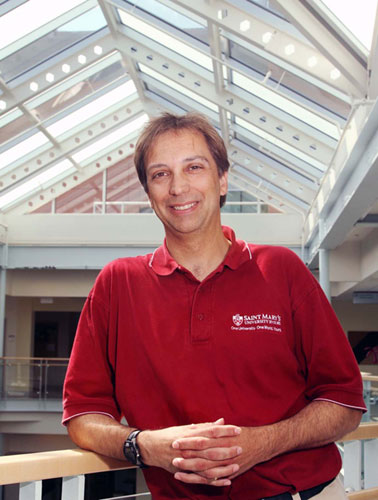 Adam Sarty, Saint Mary's University physics professor and long-time member of JLab's user community, is among the 2011 recipients of the 3M National Teaching Fellowship.
Physics professor and long-time member of Jefferson Lab's user community, Adam Sarty, Saint Mary's University in Nova Scotia, recently received a 3M National Teaching Fellowship – the highest teaching honor in Canada. With missionary zeal, Sarty fights against the physics-phobia that is prevalent in mainstream culture, attempting to de-mystify physics – both within the walls of the university and outside of them. "Physics is not hard or mysterious," Sarty says. "It is an extraordinary way of organizing and describing all that we see around us every day. And yes, physics is fun." "I feel very honored to be recognized in this way, and to have had so much help and support over the past decade from Saint Mary's and my family," he adds. Sarty is a long-time member of the Jefferson Lab user community. He has collaborated and been spokesperson on a number of experiments in Hall A dating back to 1995. Also, over the years, he has served as a research mentor for a number of graduate and undergraduate students, and has directly supervised one postdoctoral fellow, three Ph.D. students, one graduate student and six undergraduate (bachelor's of science "honors" thesis students) on research projects associated with Hall A. Currently, he is spokesperson on the "N-to-Delta" experiment which ran this past spring, and is collaborating on the next experiment to run in Hall A – E08-007, The Proton Form Factor Ratio at Low Q2 – starting this fall. He joined Saint Mary's in 2000 and his classes quickly became the talk of the campus as he sought out new ways to implement innovative teaching technologies and share the beauty of his discipline. Some of the teaching moments students recall include dropping watermelons from a third-story balcony to demonstrate a point about gravity for a local TV story, and the times he suspended a bowling ball from the ceiling, letting it swing within millimeters of his face. His style of teaching is so popular that in the early days of Facebook some former students created a fan page titled: The Dr. Adam Sarty Experience. A selection committee representing the Society for Teaching and Learning in Higher Education selected Sarty for the 3M National Teaching Fellowship based on his excellence in teaching, educational leadership, and the scholarship of teaching and learning. Across Canada, no more than 10 professors receive the award each year. He was presented with the fellowship at the annual STLHE conference hosted at the University of Saskatchewan in June, and will attend a retreat with all of this year's award winners in Banff in November. The St. Mary's news release announcing Sarty winning the award is at: http://www.smu.ca/newsreleases/2011/02-22-11-3MSartyrelease.html View a Canadian Broadcasting (CBC News) interview with Sarty at: JSA Awards Eight Graduate Fellowships for Research at Jefferson LabJefferson Sciences Associates has announced the award of JSA/Jefferson Lab graduate fellowships to eight doctoral students who will use the fellowships to conduct research at their universities and at Jefferson Lab. The 2011-2012 fellowship winners include: JSA/JLab fellowship recipients attend universities that are members of the Southeastern Universities Research Association, a consortium of more than 60 leading research universities. The students' research proposals cover a broad scientific spectrum, including experimental physics, theoretical physics and particle accelerator research and development. The SURA Board of Trustees first established the fellowship program in 1989. Since then, 164 fellowships have been awarded to students from 19 different SURA-member universities. The JSA/JLab Graduate Fellowship Program is now supported by the JSA Initiatives Fund. Each fellowship award is comprised of one-half of an academic year research assistant stipend, plus a $2,000 supplement. Each student's home institution matches half of the research assistantship. An additional $2,000 is also available for research related travel support for the student. The committee that reviewed and selected this year's fellowship winners was chaired by JSA Programs Committee Chair and JSA Board Director June Matthews from MIT. Other committee members included Hari Areti, JLab; Elizabeth Beise, University of Maryland; Lawrence Cardman, JLab; Gerard Gilfoyle, University of Richmond; Zein-Eddine Meziani, Temple University, Joerg Reinhold, Florida International University; and Elizabeth Lawson, SURA/JSA. "The research being conducted at the Jefferson Lab continues to draw students to the field of nuclear physics. The fellowship program provides opportunities for qualified students to enhance their research capabilities by linking their academic studies with the lab's science and technology programs," said Matthews. JSA President and Jefferson Lab Director Hugh Montgomery noted, "The fellowship winners are among the best and brightest students, and their selection makes it possible for them to become fully immersed in their research while also tapping into the unique capabilities of Jefferson Lab. It is because of programs such as the JSA/JLab graduate fellowships that Jefferson Lab is able to produce about one-third of the U.S. Ph.D.s in nuclear physics each year. More importantly, we are helping to educate and train the next generation of science leaders and increase science literacy, while furthering the lab's mission to gain a deeper understanding of the structure of matter." JLab Teacher Enrichment Program Wins Award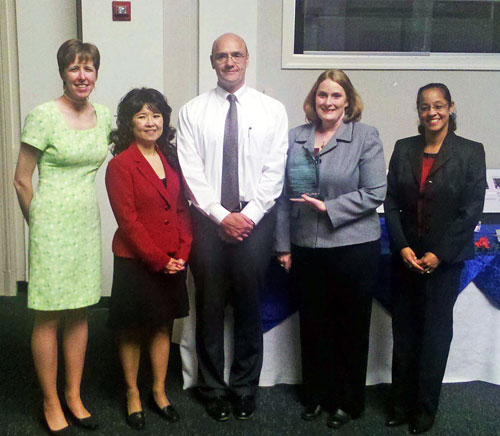 Members of JLab's Science Education group involved in JSAT were recognized by Eric Rhoades (center), Virginia Department of Education science coordinator, at the VMSC awards event held in May. Pictured with Rhoades are (from left): Brita Hampton, Science Education administrator; Elizabeth Lawson, Jefferson Science Associates Board liaison and Initiatives Fund program manager; Jan Tyler, Science Education manager; and Lisa Surles-Law, JSAT program administrator.
The Virginia Mathematics and Science Coalition has recognized Jefferson Lab's Science Activities for Teachers program, or JSAT, with a Programs That Work award. The VMSC is an alliance of education, corporate, and public policy leaders working together to revitalize mathematics and science education in prekindergarten through graduate school. The coalition recognized JSAT, Jefferson Science Associates and the Jefferson Lab's Science Education staff that manage the program among the field of award recipients at the 2011 Programs That Work event held at the Science Museum of Virginia in Richmond on May 10. According to the VMSC webpage, the awards "recognize exemplary mathematics and science programs for which there is evidence of a positive impact on student or teacher learning." JSAT is a science enrichment program for fifth-, sixth- and eighth-grade teachers of science. The after-school program, designed to increase teachers' knowledge of the physical sciences and strengthen their teaching skills, runs from in the evenings from September through May. The curriculum includes interactive activities to enhance physical science instruction at the upper-elementary and middle-school levels, and lectures by Jefferson Lab staff on the applications of science. Topics include matter, atomic structure, energy transfer, force and motion, magnetism and electricity, waves and sound, simple machines, watershed cycle and optics. Program participants receive supplies and materials so they may conduct all the program activities in their own classrooms, and at the end of the year they participate in a Teachers' Night where they demonstrate their favorite classroom activities to the hundreds of teachers who attend the lab event. "At the elementary and middle-school level, teachers, with little or no formal background in science education, often find themselves tasked with teaching the science curriculum," explains Lisa Surles-Law, program administrator. "This program is a primer for them and a refresher for those with a formal education in science. JSAT provides attendees with a wealth of materials and activities to take back to their classrooms, and a chance to network with other teachers." The program, begun in 2006, is one of many programs funded by the Jefferson Science Associates Initiatives Fund. It addresses components of National Science Education Standards and the Virginia Standards of Learning. Information about the JSA Initiatives Fund is available at: http://www.jsallc.org/IF/IFIndex.html . Additional information about JSAT, and the application form for the 2011-2012 session starting in late September, are available at: http://education.jlab.org/jsat/ or by emailing Surles-Law at: surles@jlab.org . W&M Grad Student Gets Taste of Physics While Conducting Research at JLab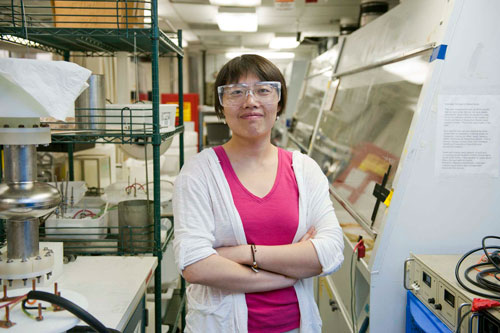 Liang Zhao, a College of William and Mary doctoral candidate, is conducting research in the Test Lab's R&D Chem Room. Behind her is some of the equipment she uses while carrying out experiments related to electropolishing (EP) or buffered chemical polishing (BCP) of niobium.
Born in Shenyang, the capital of Liaoning Province in Northeast China, Liang Zhao was surrounded by science from the day she was born. Her father, uncles and grandfather were metallurgists, and her mother worked in environmental management at a large park near their home. An only child with innate concentration skills, Zhao had a nearly idyllic upbringing, spending long hours in the park with her mother and hearing the excitement of science from the men in her life. Their influence on her to study science, however, was subtle. "What they wanted for me was that I would have a skill that would never expire," she said with a shy smile. By 2007, she completed a bachelor's degree in Engineering in Corrosion and Protection of Materials and a master's in Materials Science and Engineering at the Beijing University of Aeronautics and Astronautics. She did so well as an undergraduate that the qualifying test to go on to the graduate program was waived. By the fall of 2007, she was at the College of William and Mary as a doctoral candidate in the Department of Applied Science, where she expects to complete her Ph.D. in another year or two. Her William & Mary advisor, Michael Kelley, encouraged her to come to JLab as a research assistant. She now works part time for Kelley and Charlie Reece, the SRF Institute's deputy director, in the Superconducting Radiofrequency Institute at the Test Lab. Zhao is studying the effects of electro-polishing niobium, under a range of conditions. "It's so deep," she remarked. "I knew nothing about accelerators before coming here." Arriving at William & Mary, her first time in the U.S., she sought out friends by joining the college's Chinese Students and Scholars Association. She was also interested in making American friends and enhancing her English-language skills, so much so, that she took training to become a disc jockey at the college's radio station. "I heard a lot of good, non-mainstream music while I was doing that," she noted of the opportunity. Music plays a large part in her life outside of academics and work at the lab; she is interested in music ranging from pop to jazz, and she excels at playing piano. Listening to American radio while she commutes from her home in Williamsburg helps her English skills, too, especially National Public Radio, which she credits with making her a better listener of the language. She also shares her own language skills as a Chinese tutor with middle- and high-school students in Williamsburg. "I'm not a person of a lot of travel. I'm quiet, but I like hanging out. I like to try different things and to meet different people," Zhao said. The inveterate bicycle rider took part in a "ride to work day" with the science librarian at William & Mary, and she has forged new friendships at the college's gym, where she can be found working out nearly every day. "Exercising regularly is a necessary part of my life," she said passionately, "whether it's jogging, walking or swimming, either at the gym or near my neighborhood. I also like going to the farmer's market and art market in Williamsburg to experience American culture. Doing research can make you mentally exhausted, so I need these hobbies to keep myself recharged from time to time." Being part of the university community and the Jefferson Lab community at the same time has afforded her the opportunity to experience two diverse cultures. "The undergrads are so energetic and fun, and at the lab the people are more established, older, and have a more traditional culture. I enjoy and benefit from both." Like most newcomers, Zhao has found a welcoming environment at the laboratory. "Everyone is very patient about my broken English. The Americans who are here are used to talking to people from other cultures, and that helps a lot." By Judi Tull Staff Members Form Occupational Medicine Support Team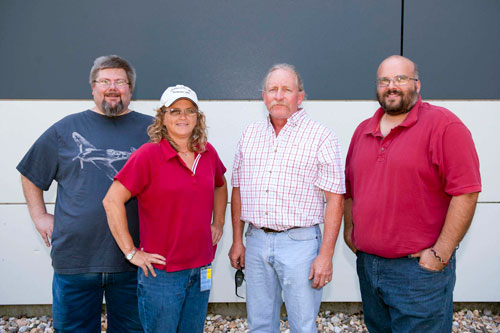 Four members of the lab's staff make up the Voluntary Occupational Medicine Support Team. Pictured are team members Eric Forman, Accelerator Division; Tina Menefee, ESH&Q Division; Kevin Sullivan, Engineering Division; and Mike Merz, Accelerator Division. Their role is to respond to 911 calls at JLab and provide assistance when needed and requested by employees, before emergency services or the lab Occupational Medicine staff arrive.
Four members of Jefferson Lab's staff have formed a Voluntary Occupational Medicine Support Team that operates under the direction of Dr. W. Smith Chandler, JLab's Occupational Medicine director. Their role is to respond to 911 calls at JLab, and provide assistance when needed and requested by employees, before Newport News emergency services or the JLab Occupational Medicine staff arrive at the scene of an emergency. They do not replace or delay ambulance or the Occupational Medicine staff's response. Along with Occupational Medicine staff, the Voluntary Occupational Medicine Support Team members are automatically notified when 911 is called from Jefferson Lab. "Because of the nature of their respective jobs and where they work, they are often close by when emergencies occur and can help speed response efforts," Dr. Chandler comments. "Their emergency medical response knowledge and experience will be a benefit to the JLab community. Thanks to Eric, Tina, Mike and Kevin, we are all safer." Each VOMST member is a licensed Emergency Medical Technician (EMT); and each voluntarily serves the Emergency Medical System (EMS) in the community where they live. Team members are:
Contact Dr. Chandler, ext. 7455 or email chandler@jlab.org, if you have questions or suggestions regarding the team. Lab's Science, Math Outreach Program Seeks Your Help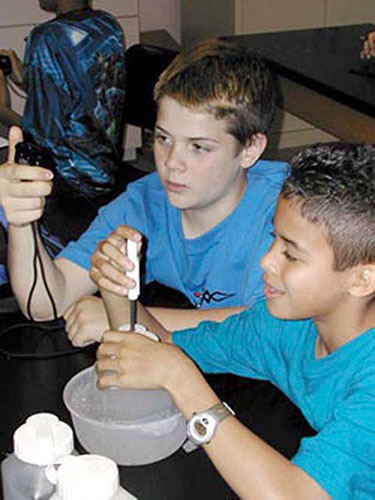 BEAMS students learn about energy transfer, insulators and scientific procedure during the Cold Stuff activity.
Becoming Enthusiastic About Math and Science – or BEAMS – Jefferson Lab's long-running math and science enrichment program for students needs your help. Lab staff, users and students interested in assisting with student activities conducted at the lab during normal business hours are encouraged to contact Christine Wheeler, Science Education. BEAMS supports Newport News inner-city public school students as they progress from sixth through eighth grade. Nearly 1,500 students and their teachers visit JLab between two and five days each school year to participate in science and math activities conducted by scientists, engineers, technicians and administrators. Volunteers spend about 75 minutes in a BEAMS classroom (VARC, Building 28, rooms 72A & 72B), either leading an educational activity or assisting students as they carry out an activity. Volunteers are also needed to provide 15-minute Role Model visits in their office or other appropriate work area for the students. "If you aren't available for a longer activity, Role Model visits are a great way to help out," Wheeler notes. The 2011-2012 round of BEAMS class visits will begin in early October and will run through May 2012. Usually two classes attend at a time and participate in two to four separate activities during each day-long visit. Volunteers are currently needed to lead or help with the following activities: Later in the school year volunteers will be needed to lead or help with these and other activities, including: "JLab staff, students and users are critical to the success of the lab's science education programs, especially BEAMS," Wheeler says. "Our BEAMS volunteers have been sharing their passion and excitement for math, science and technology with students for more than 19 years. Students get to learn about you and your job and you get to have fun working with lots of smiling faces. Everybody wins!" "From right here at the lab, you have a chance to make a difference in the lives of these students. We're always happy to welcome back volunteers who have helped in the past, and we are eager to welcome first-time volunteers," she adds. "Want to help, but not sure how? That's what we're here for," Wheeler explains. "Science Education staff will provide the training you need. Members of the education group are happy to go over any activity whether you are new to the program or if you'd like a refresher. If you want to observe a classroom activity to see if it's something you want to do, we can schedule that, too." For additional information, class visit schedules and activity opportunities, contact Wheeler at ext. 7560 or email wheelerc@jlab.org . The program's goals include: motivating students to boost their learning; strengthening students' math and science skills with hands-on activities, and having them interact with individuals who use math and/or science in their daily work environment. BEAMS also provides teachers with classroom activities based on JLab science and technology. You may view several of the activities' work sheets at the following pdf links: Decade of Jefferson Lab Physics Now Available in Print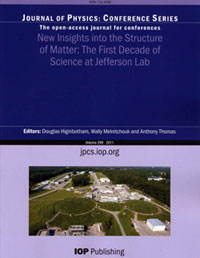 "New Insights into the Structure of Matter: The First Decade of Science at Jefferson Lab" is now available in print. The publication is available on the brochures table in the CEBAF Center lobby.
More than 2,000 physicists have conducted research at Jefferson Lab through the years, slowly adding to mankind's knowledge of the smallest building blocks of the visible universe. Now, the first comprehensive review of this body of research has been made available in the volume, "New Insights into the Structure of Matter: The First Decade of Science at Jefferson Lab." The publication features 14 major scientific research themes, as described by small groups of scientists who were integral to conducting the research. These themes encompass results from nuclear physics research, accelerator research and free-electron laser research. In addition, the publication provides a first-person account of the founding of Jefferson Lab. The journal is online at the Institute of Physics' (IOP) webpage at: http://iopscience.iop.org/1742-6596/299/1 Copies of the print publication are now available on the brochures table in the CEBAF Center lobby. For quantities of the publication, please contact Douglas Higinbotham, Physics Division, at doug@jlab.org.
Scrapbook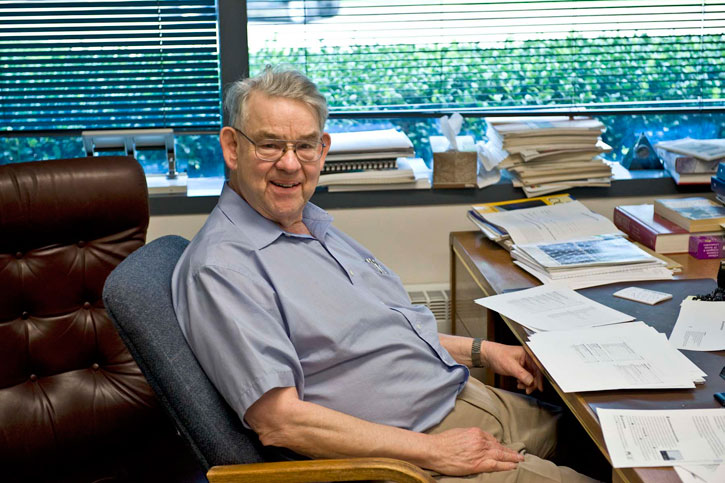 John Domingo, Physics Division, retires
Jefferson Lab has reached the end of an era with the retirement of John Domingo, Physics Division senior advisor, in August. Fortunately, the lab won't lose Domingo entirely, since he plans to return regularly as a member of the lab's user community
Quark Cafe Staff Member Earns Recognition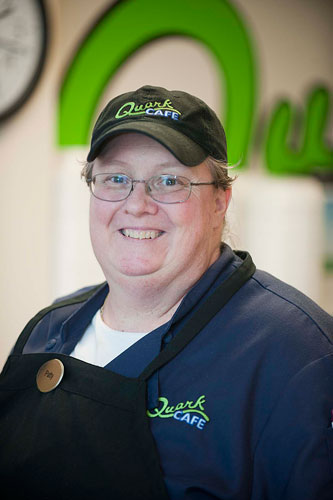 Patty Barry
Quark Cafe Quark Cafe staff member, Patty Barry, was recently recognized by her employer, Eurest Dining Services. Eurest's "Recognizing a Hero" program acknowledges and awards associates who go above and beyond their commitment to service excellence and for outstanding achievements, according to Pam Neff, district manager. All award recipients receive a Hero lapel pin and a Hero Certificate of Recognition for suitable for display. Barry, a food service worker, has been the Quark Cafe grill cook since January 2009. Soon after joining the team, it became evident that she was perfect for the job, says Gaye Davenport, Barry's supervisor and Quark Cafe Food Services director. "Breakfast customer counts have doubled in her two years in the position," Davenport notes. "Patty's motto is, 'If you can dream it up, and I can find the ingredients here, I will make it for you!' She has a regular following who walk in the door and simply order 'the usual' or 'make me something special today'; and she does it, all while carrying on several different conversations with individual customers." "Patty is loved by customers and fellow associates and continually provides an excellent customer experience," Davenport notes. "For Valentines Day, she hand wrote Valentines greetings and gave them out to every customer. St. Patricks Day was renamed 'St. Patty's Day' by our customers." "Patty exemplifies the passion for a great cutomer experience," her supervisor adds. "After her vacation to Las Vegas, Patty came back with a Noodle Bowl idea that we showcased for a chef's table and customers loved It! Patty created Gourmet Omelette recipes, recharge Wednesday ice cream specials, and received rave reviews for her Stuffed French Toast recipe." "Patty's smile is contagious and she helps the team maintain a positive 'can do' attitude. Having been in the hospitality industry for over 20 years, it was my pleasure to recognize Patty Barry as a 'Eurest Hero'!" Eurest is the Charlotte, N.C.-based company that has the contract to provide food services at Jefferson Lab. Milestones for July through August 2011Hello Michael Burke, Hall B Mechanical Technician, Physics Division Goodbye Geoffrey Arnold, Accelerator Division Jefferson Lab is currently seeking qualified individuals for a range of positions. More than 15 engineering, technician and scientific employment opportunities are currently posted at: http://www.jlab-jobs.com/ . In Memoriam: Former JLab Staffer Hugh Williams Died Aug. 7Former JLab Staffer Hugh Williams Died Aug. 7 Former Jefferson Lab Safety Engineer Hugh D. "Skip" Williams, 73, died on Aug. 7, after a prolonged illness. A memorial service was held Sept. 10, at Williamsburg Presbyterian Church in Williamsburg. He worked for several years as a safety engineer with Jefferson Lab's (then) Environmental, Health and Safety group. He is survived by his wife of 51 years, Kari; his sons, David and Thomas and their families; his sister, Judith and her husband, Steve; and mother-in-law, Margit Nordhus; as well as many other relatives and friends. Williams was born Feb. 14, 1938, in Pittsburgh, Pa. He graduated from Mt. Lebanon High School in Pittsburgh, in 1956 and entered the Coast Guard Academy. While sailing on the USCG Training Barque Eagle as a cadet, he met Kari in Bergen, Norway, on his first stop. They were married on June 11, 1960, at Mt. Lebanon Presbyterian Church, shortly after his graduation with a bachelor's of science. He was a member of the Williamsburg Presbyterian Church and a former church elder. He served on the Architectural Planning and Review Board for the city of Williamsburg and was a member of the Williamsburg Masonic Lodge and a member of several other organizations. Williams enjoyed reading, taking long walks, helping others, and inventing. He holds two patents, an oil storage container and water separator and a utility patent related to smoke and carbon dioxide detection. Williams will be interred, with full honors, at Arlington National Cemetery. The full obituary is on the Daily Press website at: http://www.legacy.com/obituaries/dailypress/obituary.aspx?n=hugh-d-williams&pid=153073601 |
|
The On Target newsletter is published monthly by the Thomas Jefferson National Accelerator Facility (Jefferson Lab), a nuclear physics research laboratory in Newport News, Virginia, operated by Jefferson Science Associates, LLC, for the U.S. Department of Energy's Office of Science. Possible news items and ideas for future stories may be emailed to jlabinfo@jlab.org, or sent to the Jefferson Lab Public Affairs Office, Suite 15, 12000 Jefferson Avenue, Newport News, VA 23606
|


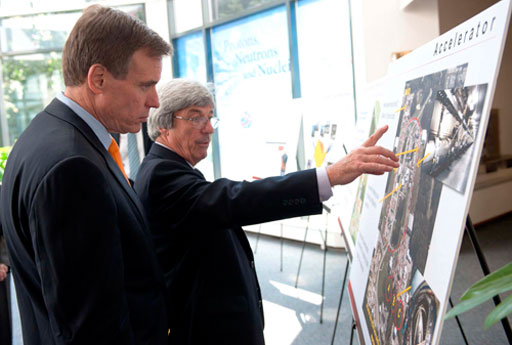
 In the weeks before the six-month shutdown, Jefferson Lab's CEBAF accelerator churned out record numbers of electrons for experiments.......
In the weeks before the six-month shutdown, Jefferson Lab's CEBAF accelerator churned out record numbers of electrons for experiments....... Jefferson Lab has successfully completed the final step in seeking certification of the lab's Integrated Safety Management System.....
Jefferson Lab has successfully completed the final step in seeking certification of the lab's Integrated Safety Management System..... In some ways, life has come full circle for Senior Engineer Kelly Dixon......
In some ways, life has come full circle for Senior Engineer Kelly Dixon......